
The Aizoaceae, or fig-marigold family, is a large family of dicotyledonous flowering plants containing 135 genera and about 1800 species. They are commonly known as ice plants or carpet weeds. They are often called vygies in South Africa and New Zealand. Highly succulent species that resemble stones are sometimes called mesembs.

Lithops is a genus of succulent plants in the ice plant family, Aizoaceae. Members of the genus are native to southern Africa. The name is derived from the Ancient Greek words λίθος 'stone' and ὄψ 'face', referring to the stone-like appearance of the plants. They avoid being eaten by blending in with surrounding rocks and are often known as pebble plants or living stones. The formation of the name from the Ancient Greek -ops means that even a single plant is called a Lithops.

Lithops viridis is a species of plant in the family Aizoaceae. Its rocklike leaves protect it from predators. Its leaves are succulent. The daisy-like flowers close at night, and this one is one of the handful of Lithops with green leaves. Its two leaves are formed like a sprouting bean.

Leaf window, also known as epidermal window, and fenestration, is a specialized leaf structure consisting of a translucent area through which light can enter the interior surfaces of the leaf where photosynthesis can occur. The translucent structure may include epidermal tissue, and in some succulent plants it consists of several cell layers of parenchyma, which may also function as water-storage tissue. It can appear as a large continuous patch, a variegated or reticulated region, or as numerous small spots. It is found in some succulent plants native to arid climates, allowing much of the plant to remain beneath the soil surface where it is protected from desiccation by winds and heat while optimizing light absorption. Many species featuring leaf windows are native to Southern Africa.
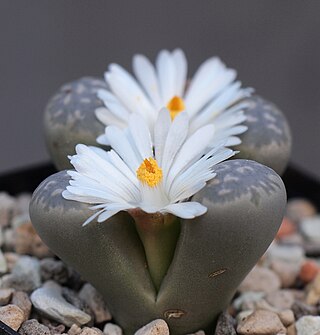
Lithops marmorata is a species of succulent pebble plant. It is native to Southern Africa. The specific name is derived from the Latin word marmorata meaning "marbled."

Lithops olivacea is a species of the genus Lithops under the family Aizoaceae. The name olivacea refers to the Latin word for olive (oliva) combined with the suffix -cea, meaning "of the likeness," producing the idea of "olive likeness." Lithops olivacea grow primarily in the Bushmandland of South Africa. They grow most abundantly in the regions of Aggeneys, Pofadder, and Namies. L. olivacea also received the Royal Horticultural Society's Award of Garden Merit for being "excellent for ordinary use in appropriate conditions, available to buy, of good constitution, essentially stable in form & colour, [and] reasonably resistant to pests & diseases."
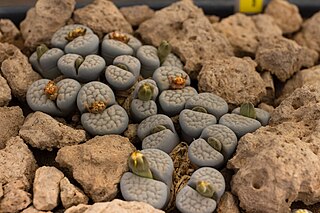
Lithops schwantesii is a succulent plant of the genus Lithops and a member of the family Aizoaceae. L. schwantesii receives its name from Gustav Schwantes, a prominent archaeologist and botanist of late 19th and 20th century. The succulent also received the Royal Horticultural Society's Award of Garden Merit for being a resilient and easy to cultivate plant.
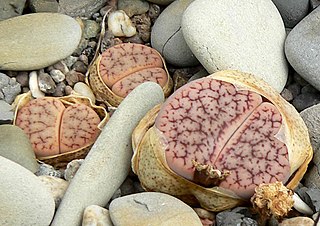
Lithops pseudotruncatella is a species of succulent in the family Aizoaceae. Initial confusion associated with Conophytum truncatum is where it derives its name, literally meaning "fake-truncatum". It also received The Royal Horticultural Society's Award of Garden Merit. The plant is found throughout much of Southern Africa.
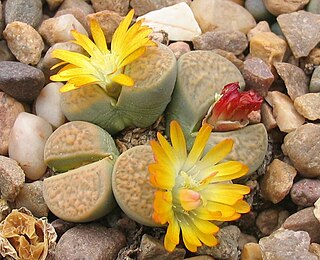
Lithops divergens is a succulent plant species of the genus Lithops under the family Aizoaceae. It grows around the regions of Southern Africa and it able to withstand intense climatic changes due to its resilience as a succulent. The average rainfall for its natural environment is less than 500mm.
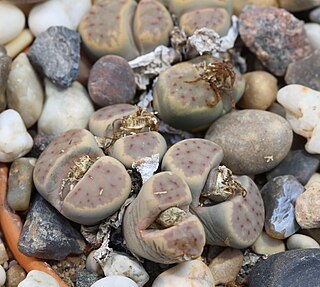
Lithops dinteri is a species of the genus Lithops of the family Aizoaceae. It is a succulent plant native to the desert climate of Southern Africa, where is receives an average yearly rainfall of 464mm. The succulent plant is named after Mortiz Kurt Dinter, a German botanist of the late 19th and early 20th century. He was a collector of exotic succulents and his collection numbered around 8,400 pressed specimens.
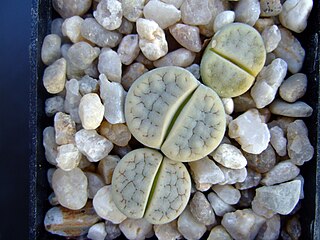
Lithops gracilidelineata is a species of the genus Lithops under the family Aizoaceae. The succulent plant lives in the southern region of Africa, and receives its name from the Latin words gracili and linea, combining to form the translation of "fine lined."
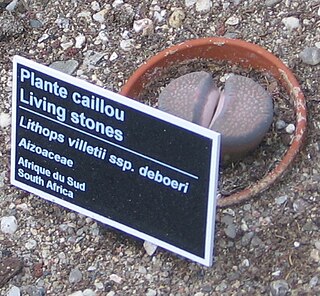
Lithops villetii is a species of the genus Lithops under the family Aizoaceae. The succulent plant is named after Dr. C. T. Villet. It is native to the Calvinia District, Namaqualand, Northern Cape, South Africa.

Lithops otzeniana is a species of succulent plant under the genus Lithops. It belongs to the family Aizoecea. L. otzeniana is native to areas of Southern Africa. It derives its name from M. Otzen, who invited its discoverer, Professor G.C. Nel, on the trip in which he discovered it.
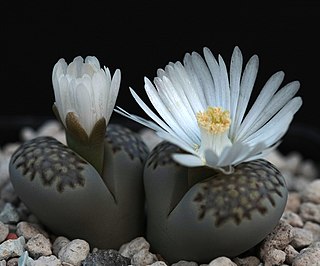
Lithops julii is a species of succulent plant of the genus Lithops under the family Aizoaceae. It is native to Southern Africa, and was first collected by Professor Kurt Dinter, a German botanist, and named after his friend, Dr. Julius Derenberg.
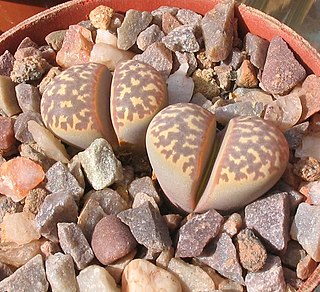
Lithops naureeniae is a species of pebble plant (Lithops). It is classified under the family Aizoaceae. The succulent is native to Southern Africa and has the ability to withstand the desert climate in which it lives. L. naureeniae was identified in 1980 by Desmond Cole, who became involved in Lithops research in 1947, from a specimen provided to him by Bruce Bayer, curator of the Karoo Botanic Garden, having been collected by Peter V. Bruyns in Namaqualand. It is named after Cole's wife, Naureen Cole. Cole wrote:
I therefore have pleasure in dedicating it to the person who, during the last fifteen years, directly and indirectly, has contributed more to research on and knowledge of the genus Lithops than any other—my wife, Naureen

Lithops meyeri is a species of living stone (Lithops), under the family Aizoaceae. It is native to Southern Africa and named after Rev. Gottlieb Meyer.
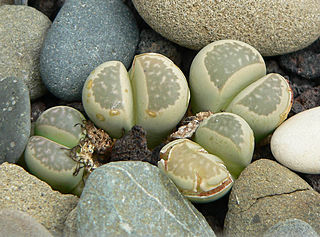
Lithops herrei is a species of succulent plant under the genus Lithops and family Aizoaceae. It derives its name from Adolar Herre, a German botanist of the 20th century.
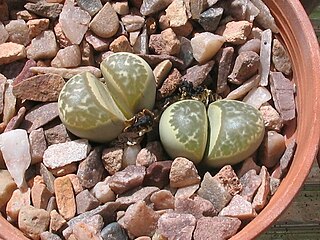
Lithops helmutii is a species of pebble plant. It is native to Southern Africa.
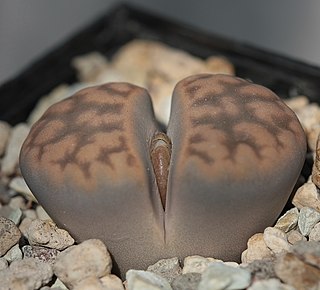
Lithops hallii is a species of living stone (Lithops) which is native to Southern Africa. It is a species of the genus Lithops under the family Aizoaceae.
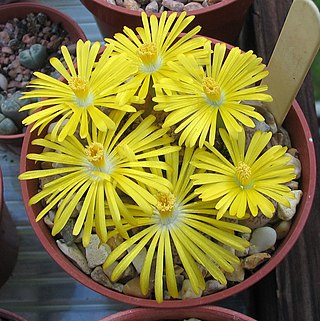
Lithops gesineae is a species of the genus Lithops under the family Aizoaceae. It is native to Namibia.




















